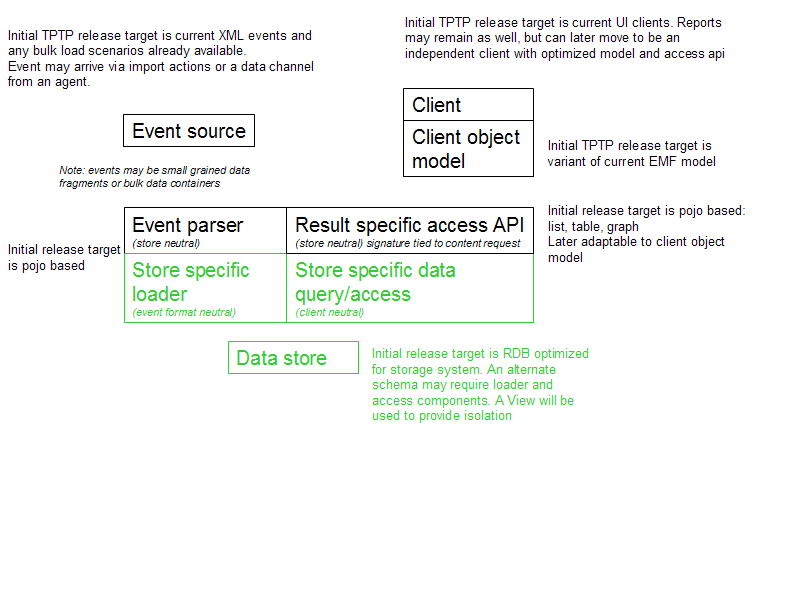Notice: This Wiki is now read only and edits are no longer possible. Please see: https://gitlab.eclipse.org/eclipsefdn/helpdesk/-/wikis/Wiki-shutdown-plan for the plan.
TPTP DMS
Contents
TPTP DMS
Requirements Overview
High Level Structure
This image shows a very high level rendering of the runtime components involved in the data flow through the data management services of TPTP.
The following gives an overview of each component in this block architecture.
Event Source
An event source is nothing more than a data provider to the loader. In TPTP this often thought to be an agent, but even though that may be where an event originated, the event source in context of this discussion is the input stream to the loader. There is an implicit contract between the event source and the loader that the data provided is consumable by the loader, however since the transport layers available in TPTP are nothing but a transport service this contract is delegated to the data source pushing data into the transport. TPTP maintains a set of specifications for event formats it can create, transport and consume. These events will continue to be extended in TPTP as the need arises. Prior to 4.4 events were small and incremental. In 4.4 bulk events will be introduced. These already in effect exist in the form of a "large" XML stream of already known events, wrapped in some sort of envelope. This is how the current trace file import works. In 4.4 we will make this more scalable from a transport and loader perspective. The design is not complete but may include options of simply passing a Uri to an batch resource of a known format. Also under consideration is embedding and CSV stream. This is not really an event source specific issue, however it is mentioned here to prevent any assumption about the structure or format of the data that may arrive through the stream.
Event Parser
The event loader consists of a few simple processing steps. The first is the event parser, the second is the store specific loader. The contract between these two components is a strongly type data object. In TPTP this object is a simple Java object. The binding between these two steps is directly controlled by the object created. Once the parser has populated the members of the object it will invoke the "add yourself" method, which will trigger the loader behaviour. This may migrate to an asynchronous event model in the future but in 4.4, parsing and loading will be synchronized operations. The role of the event parser is to instantiate the object(s) needed by the loader, and set the members as specified by the input stream. All default content must be provided by the pojo. In the current TPTP implementation, the specific event parser is selected based on the initial part of the event stream. At this time, events are formated as XML so the element name is the key used to select the parser. Alternate parsers can be easily registered for XML formated events, and with some additional work the same could be done for other stream formats. This framework allows for a complete decoupling of the input stream format from the loader by using the intermeadiate pojo.
Store specific loader
The store specific loader takes an input pojo and does what ever is needed to process and likely persist it. The historical TPTP implementation instantiated an EMF model and deferred persistence to the EMF resource serialization. Although this is still of interest for quick in memory models, it is not a completely scalable for large volumes of related data by default. Going forward, the loader is clearly bound to the storage system, and should be optimized for the data store of choice. This implies that the loader needs to be registered independent from the event parser implementation, but still needs to be coupled to it at run time. This registrations will be configurable via plug-in extensions, a configuration file or dynamically. The "add yourself" implementation of the pojo will deal with this aspect of the configuration. This approach will maintain compatibility for current extenders of the loader infrastructure.
Data store
filler
Client
filler
Client object model
filler
Result specific access api
filler
Store specific data query/access
filler

